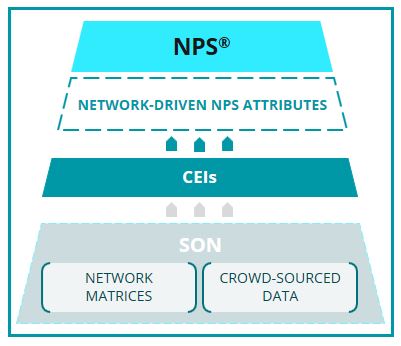Subscriber loyalty is coveted by every mobile operator, as it is the key to higher lifetime value of customers and is becoming more and more difficult to achieve.
Mobile operators’ Net Promoter Score (NPS), an index ranging from -100 to +100, that measures customers’ willingness to recommend a company, is on average +5 , far below Amazon’s NPS of +60. Any score less than +26 is purported to be the tipping point where customers are likely to churn, says Ofir Zemer, CEO of Cellwize.
In order to improve their NPS many operators are pursuing various ways to improve the customer experience. However, there are several different factors that can influence NPS including satisfaction from the mobile network, brand relationship, ease of doing business, and the degree of warmth and understanding conveyed by front line employees.
Because of subscriber’s high level of dependence on mobile devices and the hours spent using them for business, pleasure and commerce, network performance has a higher weight than other factors. Survey results from Heavy Reading show that mobile operators believe that network service quality is a top driver of customer loyalty in matured markets, taking a higher precedence to customer care or price.
Based on these findings and the growing merit of the significance the network quality has on NPS scores (aka “network-driven NPS”), it’s recommended that mobile operators focus on customer-oriented network performance to boost NPS and avoid churn.
However, a single matric often doesn’t include enough information to provide a clear understanding of the customer’s experience. For example, commuters are likely to experience more network failures (i.e. degraded customer experience) although the cell level matrices may be at an acceptable level.
Subscribers’ experiences are constructed through various journeys across network technologies from 4G to 3G and even to 2G when they fall out of coverage. Degraded experiences may go on undetected if a single technology KPI is isolated and monitored independently.
Evaluating single matrices can also mask the necessary trade-offs. For example, shrinking coverage will improve the drop call rates KPI in a given cell, causing a portion of the subscribers to handover to a legacy technology such as 2G, resulting in a poor data service experience. So this begs the question, was the overall customer experience improved or degraded?
A more accurate way to evaluate a customer experience is to create customer experience indices (CEIs), which is a composite of several network related matrices and crowdsourced data that depict a holistic view of the customer experience. Tweaking network resources to improve CEI results in improved customer satisfaction, and therefore a higher NPS.
Take for example a Tier-1 operator in Western Europe ranking 3rd out of 4 operators repeatedly by highway commuters suffering from poor network performance, specifically dropped calls. By creating a voice serviceability CEI, combining all voice related technologies and services covering 2G/3G and VoLTE along the route of major highways during early morning rush hour traffic, they were able to measure the extent of the problem.
Then by applying a cross-technology, multi-vendor SON solution, which targets the CEI in order to continuously tweak network resources, they succeeded in improving customer satisfaction by over 150%.
Mobile subscribers are more likely to recommend their operator if they have a consistently positive customer experience along the entire network journey. By creating CEIs that combine and cross network matrices to provide a more accurate picture of the customer experience and then implementing SON technology to achieve specific network performance improvements, mobile operators can increase subscriber satisfaction, and thereby NPS.
The end goal is to reduce subscriber churn, increase positive word-of-mouth, social media endorsements and enhance brand perception. Once network performance is fine-tuned so that subscribers can be ensured a quality user experience, they can become loyal, enthusiastic promoters of their mobile operator.
The author of this blog is Ofir Zemer, CEO at Cellwize.
Comment on this article below or via Twitter: @ VanillaPlus OR @jcvplus






